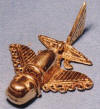|
One amazing world wide phenomenon stands out in ethnological literature: the worship of unexpected visitors of a more advanced technological culture and their technological objects.
Whenever a civilization (technologically or otherwise less advanced) comes into contact with visitors and their sophisticated technologies, which the less advanced civilization does not understand, a situation is created known as the "God effect".
Another term for it is "cargo cult", derived from the word cargo, meaning goods, and in this case the technological objects. This is how the visitors came to be worshipped as "Gods" or other supernatural beings by such tribes and peoples. And the memory of these "Gods" lived on and was passed on from generation to generation, thus becoming lore and, eventually, mythological tradition. In a way, this is a type of "archetypal reaction" typical of all civilizations.
There are examples galore.
Even in the 20th century, contacts between the natives of the islands of Melanesia and Micronesia, in the West Pacific, and US and Japanese troops during World War II, as well as many other encounters with ethnologists in the inaccessible jungles of New Guinea and South America, were marked by this "God effect". Mythology comes to life.
Once the sporadic visitors had disappeared, the natives gathered around their campfires and, naturally, shared stories about the strangers. In those stories, they passed on their impressions; and thus legends were handed down from generation to generation. Strange objects that they could not grasp within the framework of their civilization were described as "looks like". We all know of "thunderbirds" (plains) or "fire horses" (trains), etc.
Frequently, the visitors often gave the natives presents - ranging from Coca Cola cans to walkie-talkies. The natives worshipped such mementos religiously, but they also represented a challenge - they felt they had to find ways and means to persuade the "Gods" to return to them. Of course, they also wanted to enjoy the pleasures derived from these objects again. As a result, they created rituals; in Melanesia, for example, following World War II, the natives tattooed "USA" on to their skin - letters that had a "magical" significance to them and that they worshipped in spite of not knowing what they stood for.
They went on to build planes made of straw, placed on
artificial "landing strips" they had cut into the jungle. Chanting
and praying, the natives implored the "celestial beings" to return.
A real treat for ethnologists - the creation of a cult "in real
time".
Apart from stone sculptures, drawings on rocks and legends, the traditions of each civilization of that time kept those "memories of the future" alive. Religious ceremonies and rituals all over the world were kept alive throughout thousands of years. People cut wooden masks or figurines of Gods (like the "dolls" of the Hopis in Arizona or the Dogu statues of the Jomon period in Japan).
The Kayapo tribe in Brazil worship a being called Bep-Kororoti - "astronaut-like" god today symbolized by a straw man - and recite its messages - more proof of a living mythology that, to this day, relates information from a dark past.
In Colombia, for example, small "plane-like" objects of pure gold have been found. The way the wings of these objects had been arranged and their upright tail fin prompted the Aeronautical Institute in New York to start wind-tunnel experiments. Dr. Arthur Poyslee came to a positive conclusion as to the objects' ability to fly. One of these gold models (the original is on display at the Smithsonian Institute in Washington, D.C.) has been reconstructed in a true-to-life fashion - with a wingspan of 87 cm and a length of 93 cm. ("click" images to enlarge)
On August 26, 1996, this model took to its first remote-controlled solo flight, which lasted several minutes - its performance was convincing and successful in all flight attitudes. An achievement made possible by German engineers. Designer: Peter Belting. Concept by: Dr. Algund Eenboom and Conrad Lübbers.
How do archeologists interpret such curiosities? What are the conclusions drawn by other researchers?
If we are to believe observations and non-fictitious stories about encounters with strange beings, would it be possible, then, that even ancient Biblical reports might serve as historical sources?
The prophet Ezekiel witnessed a "celestial vehicle" and described its many different technical details. As a matter of fact, Ezekiel himself traveled in it and was taken to a strange temple like building. When reconstructing this account, it becomes apparent that both the description of the vehicle and of the hangar-type building could have been based on facts. The Book of Ezekiel is part of the Old Testament and, as such, widely known.
On four separate occasions, in 593, twice in 592 and for the last time in 572 BC, Ezekiel had a significant encounter with something coming down from the skies.
Look at these quotations:
"Looks like..." Using this tool of description, various objects, mostly of a technical nature, have been, and are, described or depicted in an abstract manner if such objects were unknown in one's civilization because they did not fit into the existing body of knowledge.
|


